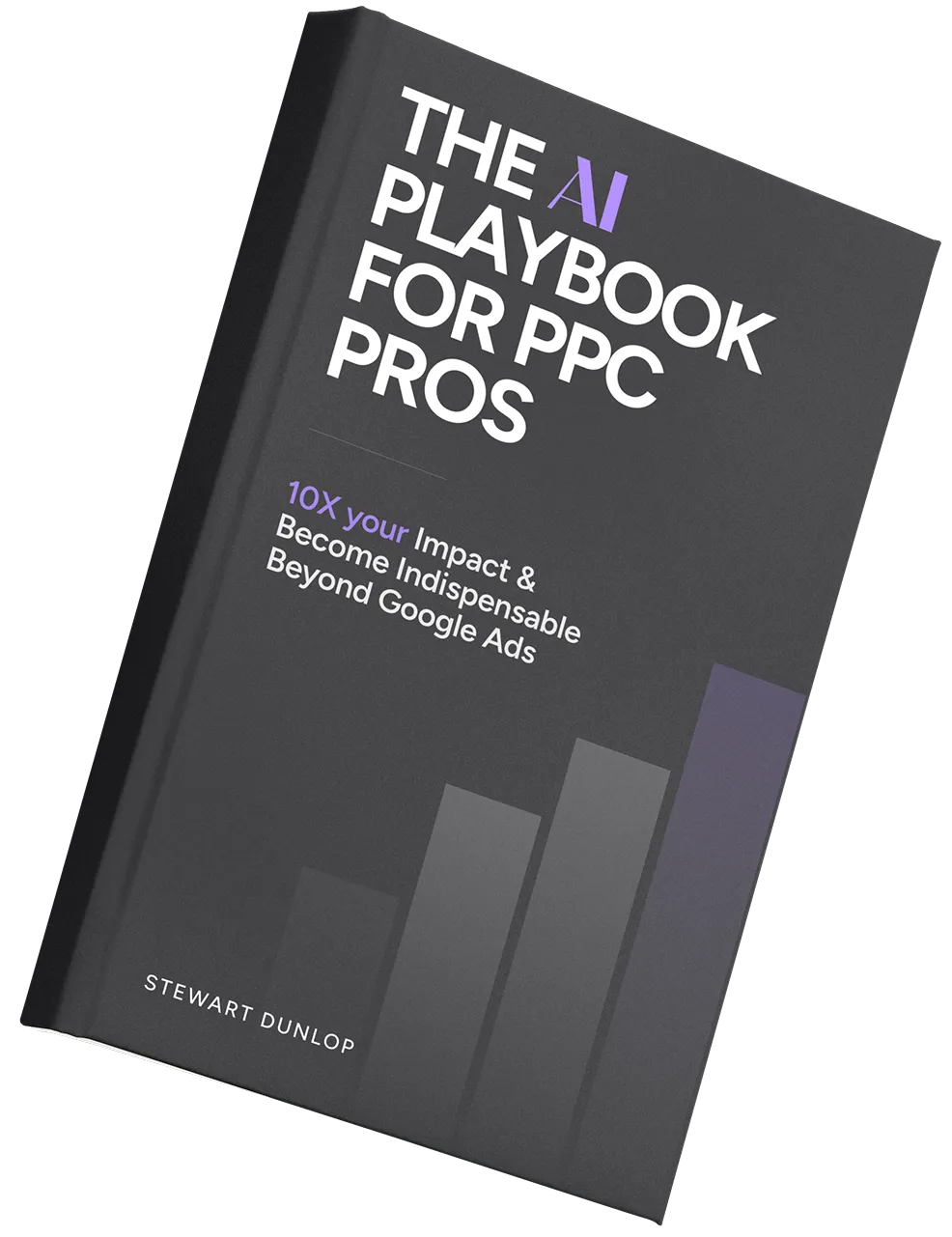
Starting a PPC campaign from scratch can be daunting—you have plenty of ideas, but no actual experience of what works for your brand.
Sure, you can take an educated guess about the types of keywords, products, and ads that will be effective. But you won’t know for certain until you’ve spent time and money testing your theories.
Unless you perform a PPC competitor analysis, that is.
Competitor analysis will show you how similar brands are already running ads. Use this information to see what works and get a head start on your own campaigns.
What Is PPC Competitor Analysis?
PPC competitor analysis is when you explore your competitors’ paid advertising campaigns to generate insights that can help your PPC efforts.
The idea is that by looking at how businesses with existing PPC experience run ads, you can see what works for these companies and then replicate these ideas.
These insights give your Google Ads campaign a head start and will help you generate a positive Return on Ad Spend (ROAS) without the need for extensive testing or large budgets.
Competitor analysis can only go so far, though. Each brand, product, and ad budget is different, so you’ll have to use your own product and audience knowledge to influence your campaign.
3 Major Benefits of PPC Competitor Analysis
PPC competitor analysis offers several benefits to the brands that use it. Here are three of the most important.
1) Get to Know Your Competition
PPC competitor analysis clearly shows which websites and brands are competing for the same terms as you.
This is important because your PPC competitors won’t always be the same as your business competitors. You’ll also get insightful information about their strategies. You’ll see estimates about how much they spend, when they run ads, and the types of products they promote.
Keep in mind that you may have to compete with businesses from different regions or countries, or other types of business such as affiliate websites or D2C ecommerce stores.
2) Get Up and Running Faster
Once you know your competitors, you can see crucial data on how they run their campaigns.
This will provide insights into what works and what doesn’t, without you having to go through a testing period.
Here’s an example of how it could help:
Imagine all your competitors are bidding on a particular keyword, and have been doing so for some time.
This suggests these brands are seeing continual success from targeting this term. It would make a lot of sense for you to target the same keyword, assuming it fits your product.
You can also see what might not work.
If none of your competitors are targeting a particular term, it may not be worth looking at. You may be able to save money by adding it to your negative keyword list.
Beyond keywords, you can also get insight into:
- Seasonality and when businesses run ads
- The offers and copy they use to convert customers
- The pages they send buyers to
- How their ads change over time
- The types of ads that Google shows for each keyword
You can use all this data to develop your own campaign.
3) Maximize Your Budget
Without competitor analysis, you’re basically starting from scratch, and this can lead to a lot of costly experimentation.
The biggest benefit of using PPC competitor analysis is that you can see what works and what doesn’t without spending money on testing this yourself.
For example, you won’t know whether a keyword converts until you’ve spent a lot of money on ads targeting the keyword. Multiply this by hundreds of paid keywords, and the costs will soon add up.
Which brings us to an additional benefit—competitor research also helps you plan your budget.
Most tools provide estimates into how much your competitors are spending, as well as seasonal fluctuations.
PPC Competitor Analysis Tools
To perform paid search competitor analysis, you need access to PPC competitor analysis tools that can provide data about competing campaigns.
These platforms let you:
- Search for websites to see which keywords they are bidding on
- See data such as the amount they spend and how this changes over time
- Look for specific keywords to see which websites are bidding on them
Each of these tools also has features to help your SEO campaigns. They’ll help you figure out how PPC advertising fits into your competitors’ overall strategies.
Here are three of the best PPC competitor analysis tools:
SpyFu
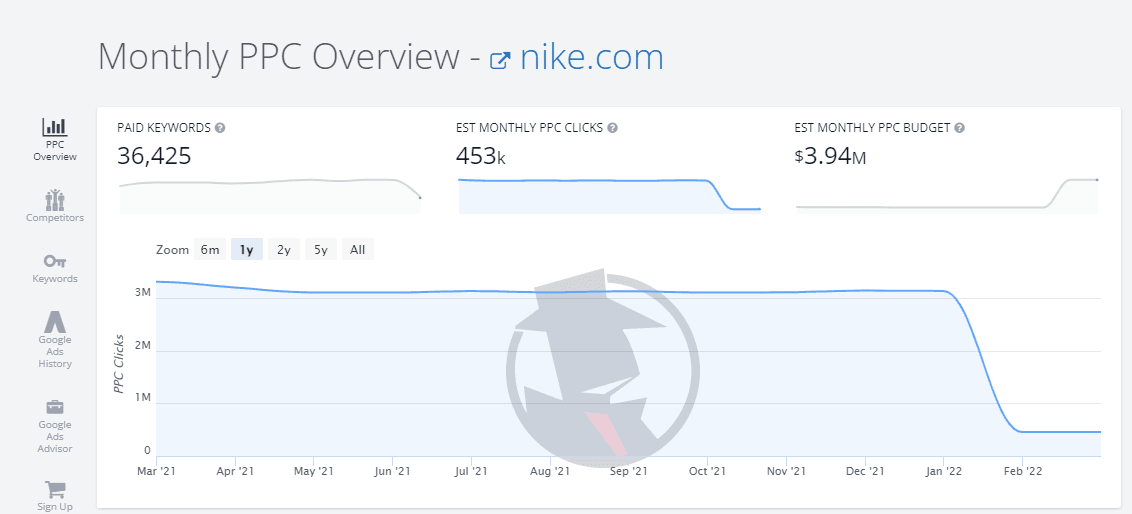
SpyFu is a digital marketing tool with plenty of features that provide insight into your competitors’ PPC campaigns.
You can:
- Gather in-depth data on all the paid keywords your competitors bid on, including the number of clicks they receive and the amount they pay
- Spot opportunities for PPC keywords your competitors bid on but you don’t
- See all the other websites that bid on the same terms you do. It’s a useful way to quickly identify emerging competitors
- See profitable keyword recommendations based on your website.
- Highlight keywords you are bidding on that competitors failed with, potentially saving you money
- Track rankings and impressions for your keywords
SpyFu costs $39 per month for its basic plan or $79 for the professional plan.
SEMRush
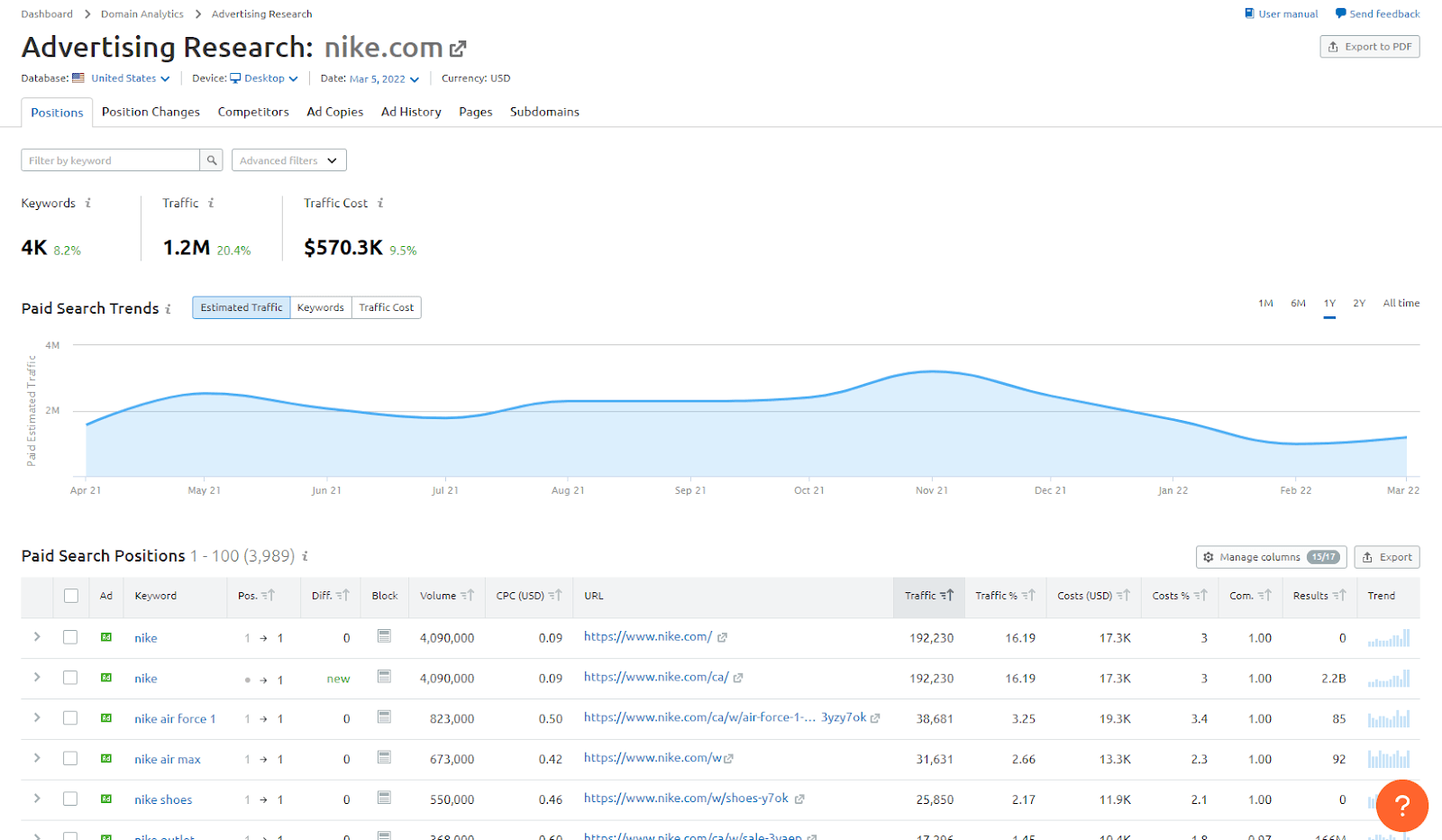
SEMRush is a search engine marketing tool that provides insight into your competitors’ strategies.
Some of the main things you can discover about competing PPC campaigns include:
- Which terms competitors bid on, and compare this to the organic keywords they rank for
- Terms that multiple competitors bid on
- CPC cost estimates at a regional level
- The history of a brand’s campaigns. See which months were busiest for each competitor and what keywords they used
- The exact ads competitors used. Use this to inspire your own campaigns
- Differences in keywords, traffic, and cost across mobile and desktop campaigns
SEMRush pricing starts at $119.95 per month and goes up to $449.95.
iSpionage
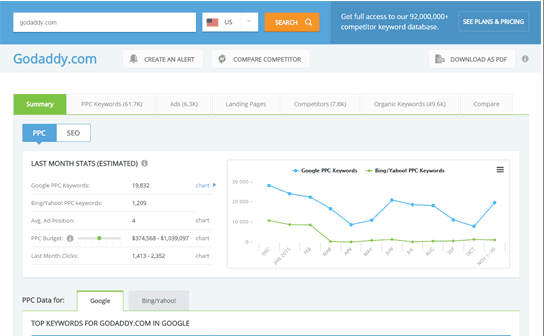
iSpionage combines SEO and PPC competitor analysis tools into a single platform.
You can discover a wide range of information about other brands’ campaigns, including:
- Who your competitors are and which keywords they bid on
- The effectiveness of keywords as rated by the iSpionage Ad Effectiveness Index
- The copy used in your competitors’ most profitable campaigns
- Campaign overviews, including traffic and how much they spend on PPC ads
iSpionage pricing starts at $59 per month and goes up to $299 for advanced plans.
For more competitor analysis tools, check out our guide here.
How to Perform PPC Competitor Analysis: 7 Key Steps
1) Discover Your Competitors
The first step in any PPC competitor analysis is to discover who your competitors are. This will show you the businesses and the types of businesses you are competing against.
You probably already have a good idea of the types of businesses you compete with. But this report can highlight unexpected PPC competition.
For example, the image below shows brands that bid on similar keywords to Nike.com.
While you might assume that Nike’s main competitors are sports brands like Adidas and Puma, when it comes to PPC spend its actual competitors are general sports goods ecommerce stores.
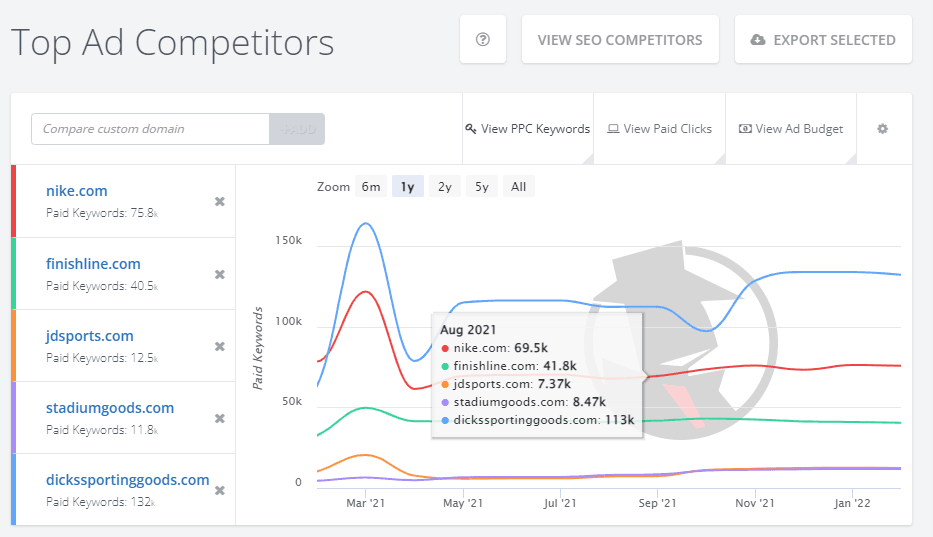
To find your competitors, you just need to search for your website on one of these platforms.
The issue is that if you haven’t yet run any PPC ads, your competitor analysis tool won’t have any data on your keywords.
But there’s an easy way around this. Instead of looking at your own site, choose a website you know you compete with to see other competitors.
Once you have a list of businesses, you can start to dig deeper into their campaigns.
2) Discover Google Ads Keywords to Bid On
Keywords are central to any effective PPC campaign. The aim is to choose ones with high buyer intent at as low a cost as possible so you can generate a positive ROAS.
PPC competitor analysis is a huge help because it shows which keywords businesses like yours are bidding on and provides insights into how they perform.
There are several ways to use competitor research to discover keywords.
Discover Top Keywords
Each keyword tool allows you to see all the keywords your competitors bid on. If a website is spending a lot of money on a particular term, it’s a good sign that the keyword is profitable.
They also provide PPC data on metrics like the number of clicks they receive, the average cost per click, and the position in the SERPs.
Below you can see the top keywords for Nike.com.
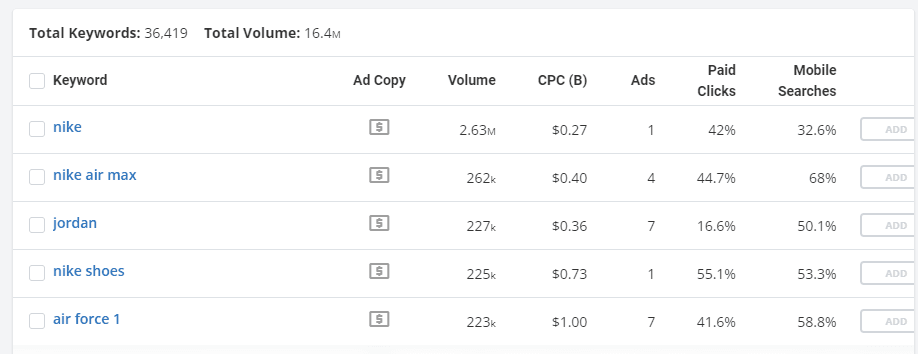
The website bids on over 36,000 keywords, so there will be plenty of keyword opportunities in the data.
Make Use of Advanced Filtering Options
Most PPC tools have advanced filtering options to streamline your keyword research.
For example, with SpyFu you can:
Filter out keywords you already bid on so you only see new opportunities Only see keywords within a specific search volumeOnly see keywords within a predefined range of CPC.
Competitor Keyword Gap Analysis
Competitor keyword gap tools are a useful way to discover keywords that multiple competitors are bidding on.
These keywords can be good opportunities because it suggests that multiple businesses are finding success by bidding on these terms.
The graph below highlights how it works.
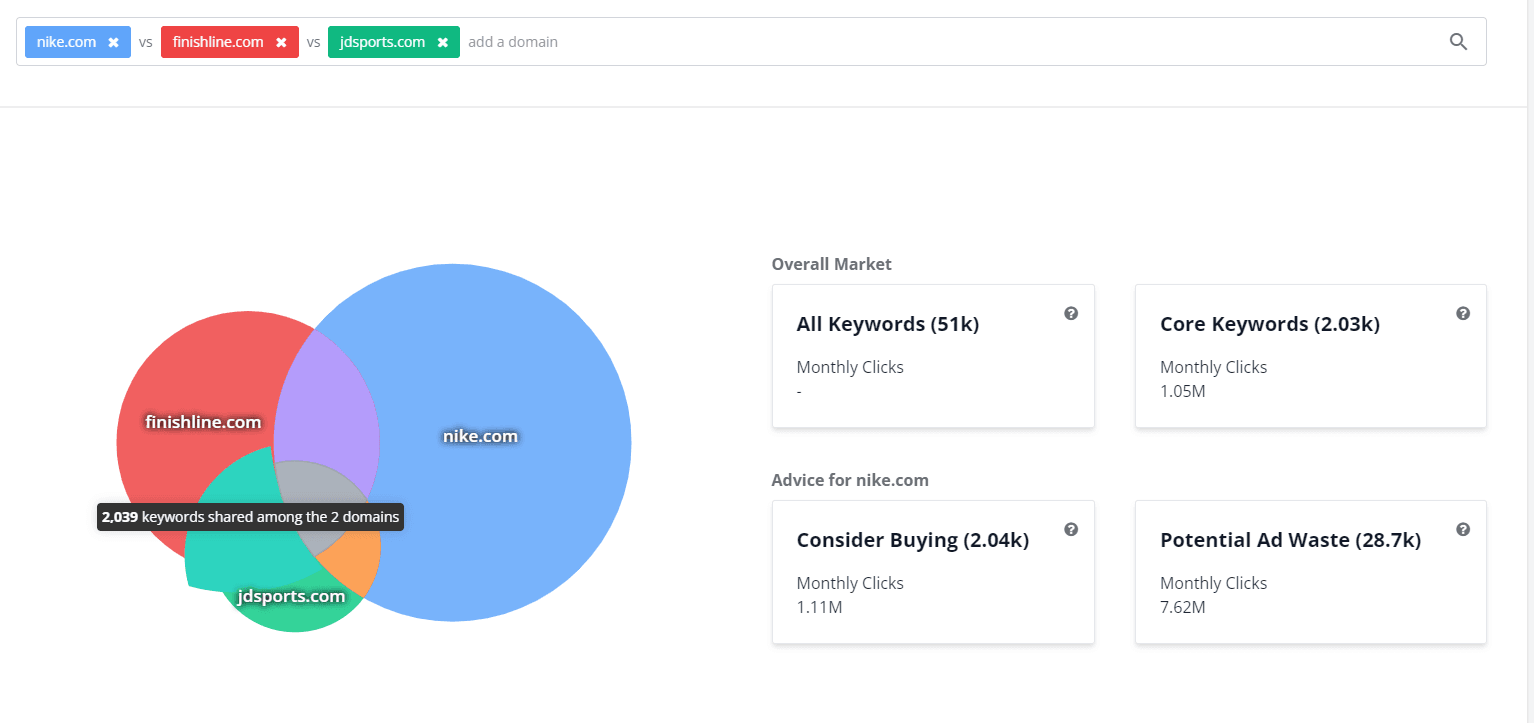
By comparing Nike with Finish Line and JD Sports, you can see there is a subsection of keywords that both JD Sports and Finish Line bid on that Nike doesn’t.
Nike could potentially find success by adding some of these keywords to its campaign.
Not all keywords in this section are going to be worth bidding on. For example, the top five results in this report include the terms “Crocs,” “NMD,” and “Stan Smith,” which are all keywords relating to footwear sold by brands other than Nike.
But, as long as you are selective, you can find big opportunities. For example, the terms “Air Max 270” and “Nike Blazer Mid 77” generate tens of thousands of searches and are directly related to Nike products.

Nike could increase sales of these products by bidding on the keywords highlighted above.
3) See Keywords to Avoid
PPC keyword research doesn’t just highlight terms to target. It also shows terms that should be avoided.
Most PPC tools have a “Potential Ad Waste” section which highlights keywords you are bidding on that competitors aren’t. The idea is that if you’re the only business bidding on these keywords, it can be a sign that they don’t convert.
Of course, not all the terms in the list are waste. Some will be branded keywords or those specific to your product. Other terms may be actual opportunities you’ve spotted that competitors haven’t.
But there may also be terms that don’t fit your product or service that you’re wasting money on.
For example, Nike appears to be bidding on “Predator cleats.” As this is a search for a type of shoe sold by Adidas, it may not be the best fit for Nike. The brand may be wasting ad budget by targeting this term.

Of course, this is just speculation as Nike may have its own reasons for bidding on “Predator cleats.” But the point is that the report highlights potential waste. You can look through the list to see terms you want to remove using your own knowledge of your campaign.
There are other ways to spot potential waste.
For example, you can highlight adult terms that may have been accidentally added to your term list, and keywords that competitors have bid on previously that they now avoid.
4) Check for Seasonality
For example, you can see which brands advertise on different keywords each month. This is useful if you have a product that is affected by seasonality.
Analyzing your PPC competitors allows you to see past trends you can use to influence your upcoming strategy.
The report below shows when brands advertise on the term “Nike slides.” You can see that most activity happens in the lead-up to Christmas as well as in summer.

If you wanted to sell a similar product, you could use these insights to decide that the best times of year to advertise on this term are summer and before Christmas.
The report suggests that there might not be demand during the rest of the year. By only advertising during seasons with demand, you may avoid wasted ad spend.
5) See Ad Copy and Offers
So far, we’ve focused mainly on the behind-the-scenes strategy of a PPC campaign. But you can also use these tools to see the exact ads your competitors use during their campaigns.
This is helpful because it allows you to:
- See the ad copy they use to get people to click
- See the offers they use to entice customers
- See how ads change over time
- Look for things different competitors do similarly
- See which page the ad points to
For example, you can see how Nike’s ads look when people do a general search for sneakers, compared to how they look when people search for a type of Nike soccer cleat.

You can see that Nike has tailored the ad towards each term. Each one uses different copy, links, and offers.
You can also see how different brands advertise on the same term. The screenshot below shows the results of a search for a type of Nike soccer cleat.
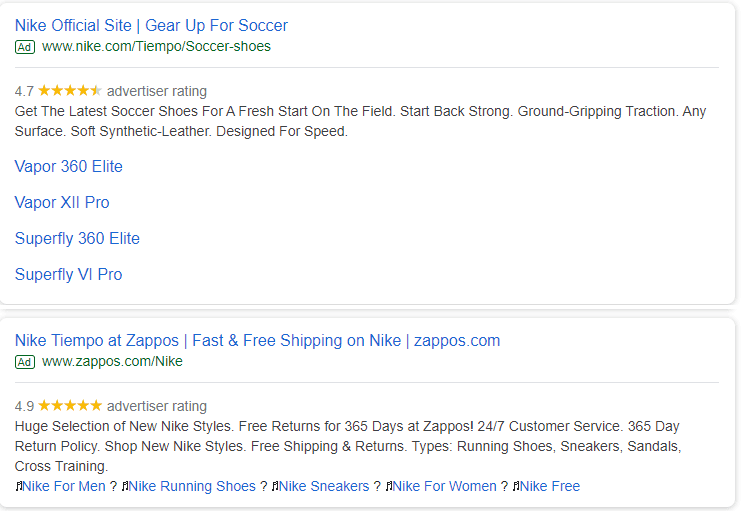
The ads hint at why Google may show one listing above another.
The Nike ad ranked higher. It is specifically about soccer and it directs customers to the page that specializes in the type of cleat the user searcher for.
On the other hand, the Zappos ad is for the ecommerce store’s general Nike listings page and doesn’t actually mention soccer at all.
Clicking on the Nike ad is more likely to result in a positive experience—resulting in its higher listing.
If you wanted to compete for this term, your best strategy would be to follow Nike’s lead and create a specific ad for soccer and a landing page for the specific type of shoe.
6) Plan Your Budget
PPC competitor analysis can help you evaluate how much you should spend on ads. It does this by showing how much money other brands are spending on their campaigns each month.
Searching for your competitors in your PPC tool will show estimates of how much the brand spends on PPC ads. And you can see how this changes over time.
You can see how this looks for the soccer equipment ecommerce seller ProDirectSoccer in the image below.
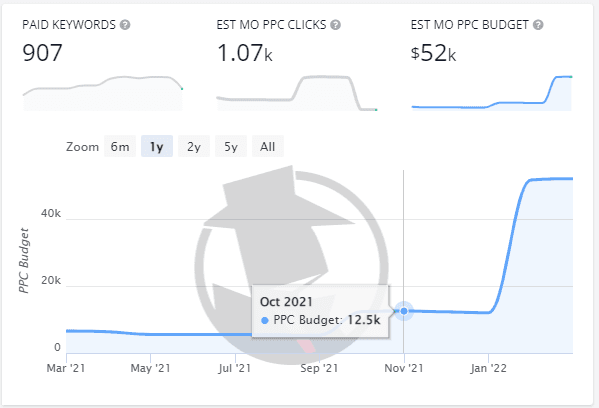
At the start of the year, monthly spending was around $5,000, before jumping to over $12,000 in September. The brand then made a big increase in spending at the start of 2022.
It’s also easy to compare this strategy to other paid competitors using the tool’s suggestions.
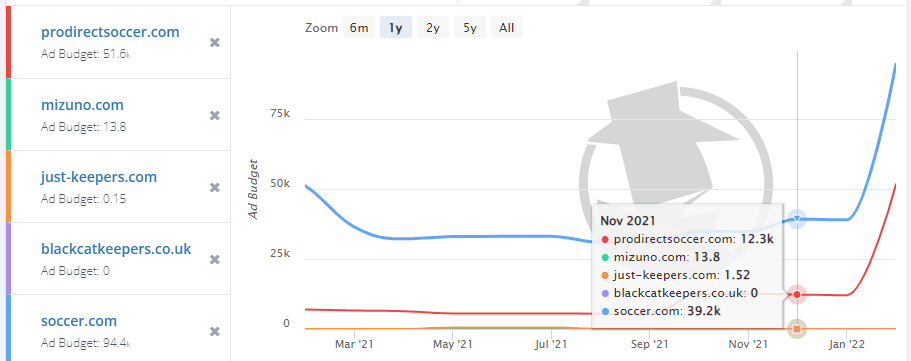
The most interesting insight from this report is that Soccer.com has a similar pattern to ProDirectSoccer over the last year.
This could be for many reasons. It could be that people weren’t looking for soccer cleats during the start of the year due to the pandemic, and that this slowly started to change throughout the year as restrictions ended.
Meanwhile, the increase in spending at the start of 2022 could reflect the fact that the soccer season in the U.S. starts in February, so people are looking for new cleats for the pre-season.
Whatever the reason, a website looking to get into this space can look at this data to see how much competitors are spending at different times of the year. This can point them towards the amount they should spend to generate similar success.
7) Monitor Your Campaign
The final way to use PPC competitor research is to continually monitor your competitors once you’re set up.
The tools will show you how the competitive landscape for the above categories changes as time goes on.
You’ll be kept up to date with things like:
- New keywords that competitors begin to target
- New competitors that start targeting your keywords
- Budget changes from your major competitors
With this information, you can maintain your competitive edge as you run your campaign.
Use This Information to Inform Your Own Campaign
Once you’ve performed the above steps you’ll have a ton of information and insight you can implement within your website’s campaign.
The key is to use this data alongside what you already know about your brand and audience. Don’t blindly follow every keyword suggestion, and don’t change all your ads to reflect what is working for other brands.
Instead, take these tips and think about how they will work for your business.
